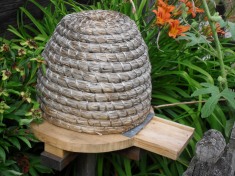Before there were goats in my life, there were bees. Or rather, there was the idea of bees. Honey bees, in particular. I am not quite sure when I developed my fascination with the tiny, often vilified, routinely overlooked little creatures, but I was well into adulthood when I became enthralled by them. Perhaps it was rumors of pollinator decline globally that concerned me, or the idea of a true matriarchal society of insects that appealed to my inner misandrist. Whatever it was, the more I learned about the hive, the queen, their complex communication system, their castes, their life cycles, the more I wanted to know. And, if you’re ever so foolish as to ask me about bees (or goats, for that matter), you’re going to be in for a really, really long talk. And by “talk,” I mean I’m going to relentlessly chew your ear off and not even notice when you stop paying attention and start playing with your phone or daydreaming about doing your taxes in the middle of the Mojave.

A year after my goat internship, I took a beekeeping class, taught by Stuart Woronecki of Stonewall Apiary out of Hanover, CT. The classes were informative, concise, and provided first-hand, expert knowledge on beekeeping, primarily for the sake of cultivating lots, and lots of honey. Mr. Woronecki advocated strongly for the common Langstroth hive, as it force bees to produce huge amounts of honey, and carefully keeps the queen separate from the honey comb so she cannot lay brood in the same frames as the workers store nectar. Langstroth hives are likely the only beehives you see now (not including the woven skeps you’ll see depicted most in art), and are quite effective at what they do. It is recommended that for maximum honey cultivation, and therefore maximum profit, the bees are routinely stripped of their summer stores and fed sugar water instead, allowing the beekeepers access to all the sticky gold. Commercial beekeepers favor these hives for these reasons, and if you have interest, you can watch the film More than Honey (it’s on Amazon and really good!) to see how thousands of frames of honey are processed at a time. (FWIW, the scene I am thinking of made my joints and heart hurt; it was so merciless.)
But as I have had several years between my beekeeping class and the opportunity to actually purchase bees, I’ve continued to read and learn and obsess. And the more I read about bees, particularly from people who love the bees more than their honey, the less the prescribed methods of beekeeping appeal to me.
I’ve come to think of honey as akin to bread. Humans cannot sustain on water and flour separately; we must combine flour and water and time (fermentation) to create bread that can nourish. The bees store nectar (that they break down into simple sugars in their honey stomachs and then puke up – yes, honey is evaporated bee vomit) over time to create the honey that nourishes them specifically. In no way can I believe that the processed granulated sugar and water that bees are fed could replace the honey they create themselves for overwintering feed. And so, that is how I came to the Warré hive.

Developed in the early half of the 20th century by a French Abbott named Émile Warré, the hive that bares his name came about after his own study and testing. After trialing 350 different hive formats, he settled on this one, which he called “ruche populaire” – the People’s Hive. Unlike many other less-intrusive beehives, like the Perone, Top Bar, or Sun Hive, the Warré is easy to use, easy to setup, and small enough to be manageable. It allows for the beekeeper to expand the bees’ living space without too much interference, and is designed so they can create comb and honey as they see fit, without chemical-laden commercially pre-pressed wax common in many hives, or the exclusion of the queen from the upper chambers.
Whether you think bees are threatened or not, Colony Collapse Disorder (CCD) is real phenomenon, the source of which still baffles scientists. My assumption is CCD is actually a combination of contributing factors: reduced resistance to Varroa mites, exposure to chemicals – especially neonicotinoid pesticides, and malnutrition from lack of their own damn honey. I’m fascinated by bees for so many reasons; even if the common western honey bee isn’t dropping dead in dangerous numbers, I’d prefer not to slowly starve the ones I bring to live with us here, making them more susceptible to the many other pests and maladies that a hive can acquire.
One of the great responsibilities of caring for animals – any member of the kingdom animalia that has come to live side by side with us – is that we do our best to do right by them. Humans will never domesticate the bee, but for all the help they provide us, the least we can do is our best to ensure a long and healthful life while they pollinate our gardens and leave honey behind.

One Comment Add yours